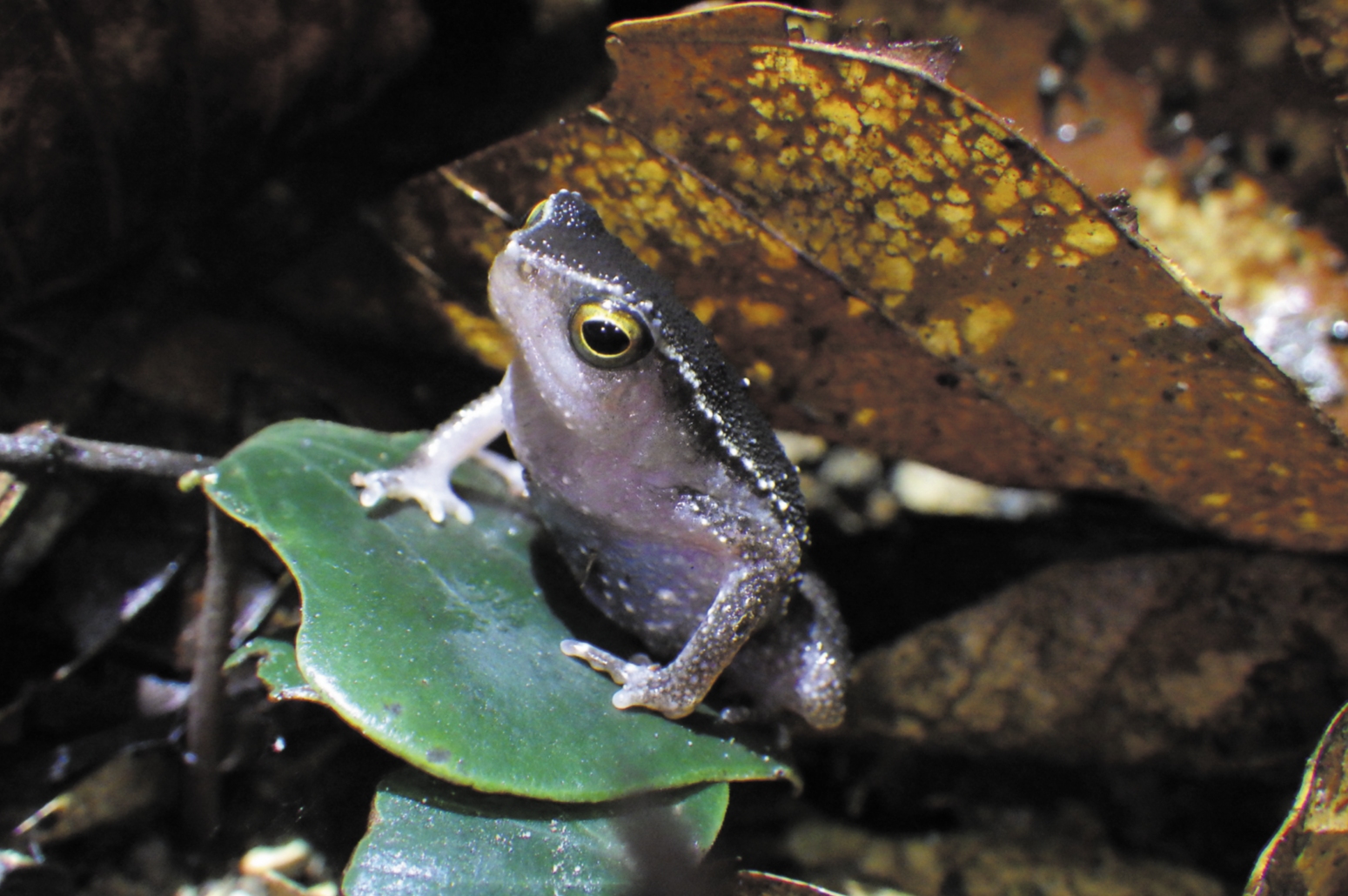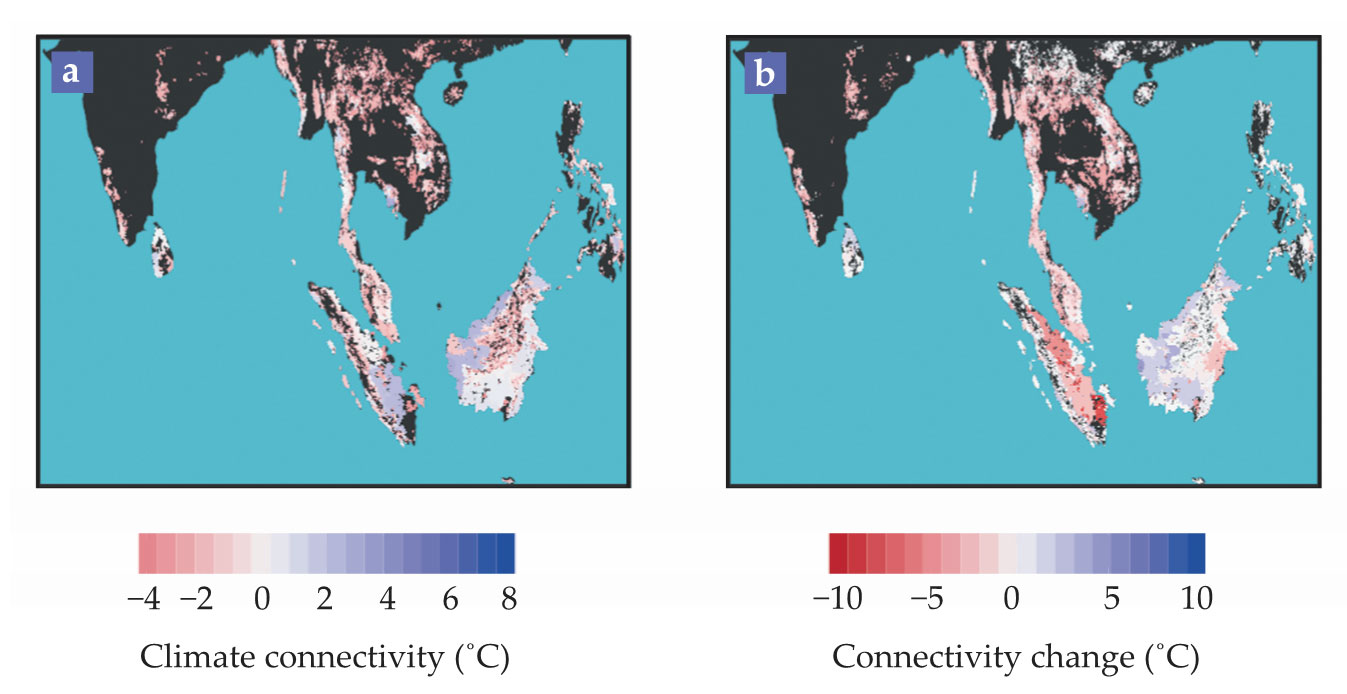Tropical biodiversity faces intersecting threats
DOI: 10.1063/PT.3.4286
Over the past half century, the Amazon rainforest has lost some 20% of its area, mostly to cattle ranching. Other tropical forests around the world have suffered a similar decline. Rainforests are home to around half of Earth’s terrestrial plant and animal species, including unknown numbers that have yet to be discovered. As deforestation continues, those species could be lost.
That’s not news, of course: Rainforest conservation movements have been around for more than 30 years. But now, Rebecca Senior of the University of Sheffield has probed the problem from a new angle: As part of her PhD research under the joint supervision of David Edwards and Jane Hill, she found that not only does deforestation reduce the amount of available habitat, it also makes it harder for rainforest species to shift their ranges in response to climate change. 1
As the world warms, species will find themselves increasingly ill-adapted to their current homes. Tropical species, such as the frog in figure
Figure 1.

This microhylid frog of the genus Kalophrynus makes its home in the rainforest floors of Borneo. The species may need to find a new habitat in a changing climate, but because the adults are only 3 cm long, they can’t disperse far.
CHLOE WALKER-TRIVETT

Species may be able to escape the worst effects of the warming climate by moving to cooler habitats, either farther from the equator or uphill, but only if they can find a sufficiently unobstructed path to get there. Deforestation breaks up those paths. Senior and colleagues found that under the most severe warming scenario, less than two-fifths of Earth’s rainforest area is connected to a region with an analogous future climate. Moreover, that number is getting worse: In 2000 almost half the rainforest was so connected.
Moving home
Senior started with a plan for a completely different project on land use, biodiversity, and climate. Many of the world’s rainforests are selectively logged, a practice that degrades the forest but doesn’t destroy it. Senior traveled to Borneo to test the hypothesis that logging would disrupt the cooler microclimates—burrows, tree holes, and the like—where animals can take refuge in especially hot weather. If she’d found a difference, she would have gone on to study the behavior of frogs in the different types of forest to see how they adapt. But in fact, the microclimates in logged and intact forests were almost identical. 2 “That’s good news for biodiversity,” says Senior, “but it rendered my original plans irrelevant.”
Her new plan was inspired by a paper by Georgia Tech’s Jenny McGuire and colleagues on the connectivity under climate change of natural lands in the US. 3 What would the same analysis reveal about the world’s tropical forests? Senior asked. The basic idea—that forest clearing would make it harder for species to move to cooler regions—had been suggested before but never rigorously tested, in part because of a lack of data on forest geography. But a set of high-resolution satellite maps, released in 2013 and covering the years 2000–12, made such an analysis possible. 4
Similarly reliable maps aren’t yet available for all the variables that contribute to a region’s projected future climate—such as rainfall and temperature variability—but for average annual temperature, at least, they are. Senior and colleagues combined the forest maps with current climate maps and the future temperature projections of the so-called RCP 8.5 trajectory, which assumes that greenhouse gas emissions continue to rise unchecked throughout the 21st century. Under that scenario, by the year 2100 the average global temperature is likely to rise by almost 4 °C, an amount that would have drastic consequences for Antarctic glaciers and thus for sea levels (see Physics Today, February 2018, page 16
The researchers deliberately sought a broad result to apply generically to tropical forest species, from insects to frogs to trees. That meant making some broad generalizations about how species propagate and disperse. “We assume that over decades, most species’ ranges will shift via populations gaining a selective advantage in the coldest parts of their range, rather than through the more sporadic movement of individuals within generations,” Senior explains. Among other things, that assumption implies that species never shift from cooler to hotter territory, even if the move would help them reach an even cooler home. Some fast-moving or migratory animals might be able to explore more possible habitats than assumed. On the other hand, slow-growing plants might not be able to disperse their seeds far enough to keep up with temperature changes, no matter how much suitable habitat is available.
Forest patches were considered to be connected to each other if they were up to 2 km apart—effectively an assumption that species can cross up to 2 km of nonforest. “This, of course, is very dependent on the species and what exactly the ‘nonforest’ is,” explains Senior. Furthermore, the researchers required that for a tropical species to get from one point to another, every region in between must have sufficient forested area—a threshold they set at 10 km2—to sustain the species at a reasonable intermediate climate. But that number, too, is species dependent. Species that can survive and reproduce in areas as small as 1 km2 may have significantly more paths available to them, whereas those that need much more room could have even more trouble reaching new homes.
Climate change is likely to create novel ecosystems, as species from different lowland regions all seek the same higher ground to escape the heat. The consequences of those encounters are beyond the scope of the study—but, as Senior notes, species have adjusted to new neighbors before. “There’s plenty of paleontological evidence that species have moved up- and downhill, or toward and away from the poles, as Earth’s climate has changed in the past,” she says. “But this is the first time that they will have to do so through such a fragmented landscape.”
Missed connection
Although crunching the data from all the world’s tropical forests was a computational challenge, the methodology was fairly straightforward: For each point of origin, find the coolest reachable destination, subject to the above rules. Then subtract the projected late-21st-century average temperature at the destination from the late-20th-century average temperature at the origin. That difference, which the researchers call “climate connectivity,” is shown in figure
Figure 2.

Climate connectivity, shown here (a) for the Asian tropics for the year 2012, is defined as a region’s current average annual temperature minus the projected future temperature of the coolest destination to which it’s connected. Positive connectivity, shown in blue, means that species stand a good chance of coping with climate change by moving; negative connectivity, shown in red, means they don’t. (b) Changes in land use between 2000 and 2012 have changed the climate connectivity in many regions. Most, but not all, of those changes are for the worse. (Adapted from ref.

Based on the global forest-cover maps from 2012, the researchers calculated that 62% of tropical forest area has negative connectivity. But the point isn’t so much about that specific number—the result of numerous generalizations and assumptions—as it is about how the connectivity is affected by human land-use patterns. That dependence is quantified by the change in connectivity between 2000 and 2012, as shown in figure
The only variable driving the change in connectivity is the change in forest cover; the initial and projected climate maps, for example, are the same in each case. Even so, much of the worldwide forest area saw a nonzero connectivity change. Most of the changes were negative, the result of deforestation that cuts off paths to cooler regions. But some were positive because forest conversion isn’t a one-way street. The world’s tropical forests saw a total loss of some 860 000 km2 between 2000 and 2012—but also a gain of 120 000 km2, which restored some paths or created new ones that weren’t there before.
If changing land use is part of the problem, it can also be part of the solution. “We’re interested in identifying the priority regions for enhancing climate connectivity,” says Senior, “where the smallest amount of reforestation would improve connectivity the most.” To do that, the researchers want to refine their model to include species-specific dispersal patterns, the effects of precipitation, and other variables that can cause species to shift their habitats. “There are a lot of open questions, and this is really just the beginning of understanding how these factors interact.”
References
1. R. A. Senior, J. K. Hill, D. P. Edwards, Nat. Clim. Change 9, 623 (2019). https://doi.org/10.1038/s41558-019-0529-2
2. R. A. Senior et al., Global Change Biol. 24, 1267 (2018). https://doi.org/10.1111/gcb.13914
3. J. L. McGuire et al., Proc. Natl. Acad. Sci. USA 113, 7195 (2016). https://doi.org/10.1073/pnas.1602817113
4. M. C. Hansen et al., Science 342, 850 (2013). https://doi.org/10.1126/science.1244693
